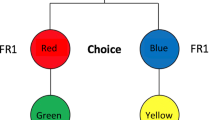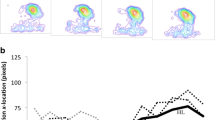Abstract
Pigeons were allowed to peck either of two side keys to produce (observe) a positive or a negative stimulus on a third, middle key. When pecks to one side key resulted in only the positive stimulus signaling fixed-interval 30 sec, and pecks to the other side key likewise resulted only in the negative stimulus signaling extinction 30 sec, the pigeons pecked the positive stimulus key almost exclusively. Two of three pigeons stopped observing when the positive stimulus never occurred. In a second experiment manipulation of the probability of fixed-interval components had a slight effect on observing responses but a larger effect on fixed-interval rate. These results support the inadequacy of an information account of observing behavior.
Similar content being viewed by others
Reference Notes
AUGE, R.J. 1975. Observing and terminating the stimulus signaling the large fixed-ratio schedule. Paper presented at the Midwestern Analysis of Behavior Association, Chicago. Abstract available from Wald.
KILLEEN, P. & WALD, B. A. 1974. Concurrent conditioned reinforcement schedules. Paper presented at the Utah Academy of Science, Arts and Letters, Logan. Abstract available from Wald.
References
AUGE, R. J. 1973. The relative nature of conditioned reinforcement. (Doctoral dissertation, Arizona State University, 1973), Dissertation Abstracts International, 33, 3330B–3331B. (University Microfilms No. 73–383).
BLANCHARD, R. 1975. The effect of S-on observing behavior. Learning and Motivation, 6, 1–10.
CATANIA, A. C. 1973. Self-inhibiting effects of reinforcement. Journal of the Experimental Analysis of Behavior, 19, 517–526.
ECKERMAN, D. A. 1973. Uncertainty reduction and conditioned reinforcement. The Psychological Record, 23, 39–47.
FANTINO, E. 1977. Conditioned reinforcement Ii: Choice and information. In W. K. Honig & J.E.R. Staddon, (Eds.), Handbook of operant behavior. Englewood Cliffs, N.J.: Prentice-Hall.
GARNER, W. R. 1962. Uncertainty and structure as psychological concepts. New York: Wiley.
HENDRY, D. P. 1965. Reinforcing value of information. Nasa Technical Report 65–1. Space Research Laboratory, University of Maryland, College Park.
HENDRY, D. P. (Ed. 1969. Conditioned reinforcement. Homewood, Illinois:. Dorsey Press.
HERRNSTEIN, R. J. 1970. On the law of effect. Journal of the Experimental Analysis of Behavior, 13, 243–266.
KENDALL, S. B. 1973. Redundant information in an observing response procedure. Journal of the Experimental Analysis of Behavior, 19, 81–92.
KENDALL, S. B., & GIBSON, D. A. 1965. Effects of discriminative stimulus removal on observing behavior. The Psychological Record, 15, 545–551.
MCMICHAEL, J. S., LANZETTA, J. T., & DRISCOLL, J. 1967. Infrequent reward facilitates observing responses in rats. Psychonomic Science, 8, 23–24.
MCMILLAN, J.C. 1974. Average uncertainty as a determinant of observing behavior. Journal of the Experimental Analysis of Behavior, 22, 401–408.
MULLER, P. G., & CHENEY, C. D. 1975. Role of the no-food stimulus duration during positive automaintenance. The Psychological Record, 25, 197–204.
MULVANEY, D. E., DINSMOOR, J. A., JWAIDEH, A. R., & HUGHES, L. H. 1974. Punishment of observing by the negative discriminative stimulus. Journal of the Experimental Analysis of Behavior, 21, 37–44.
TAUS, S. E., & HEARST, E. 1970. Effects of intertrial (blackout) duration on response rate to a positive stimulus. Psychonomic Science, 19, 265–267.
TERRACE, H., GIBBON, J., FARRELL, L., & BALDOCK, M. C. 1975. Temporal factors influencing the acquisition and maintenance of an autoshaped keypeck. Animal Learning & Behavior, 3, 53–62.
WALD, B. A., & DUKICH, T. D. 1978. Observing behavior: Redundant stimuli and time since information. Animal Learning & Behavior, 6, 380–384.
WILTON, R. N., & CLEMENTS, R. O. 1971. The role of information in the emission of observing responses: A test of two hypotheses. Journal of the Experimental Analysis of Behavior, 16, 161–166.
WYCKOFF, L. B., JR. 1969. The role of observing responses in discrimination learning. In D. P. Hendry (Ed.), Conditioned reinforcement. Homewood, Illinois: Dorsey Press.
Author information
Authors and Affiliations
Additional information
Portions of Experiment 1 were presented at the Rocky Mountain Psychological Association meeting, 1975. The first experiment was conducted at Arizona State University in partial fulfillment of the Master of Arts degree for Bruce A. Wald who is now at Brainerd, Minnesota. Experiment 2 was conducted at Utah State University. The paper has benefited from suggestions by T. D. Dukich. We thank D. A. Wald for clerical assistance.
Rights and permissions
About this article
Cite this article
Killeen, P., Wald, B. & Cheney, C.D. Observing Behavior and Information. Psychol Rec 30, 181–190 (1980). https://doi.org/10.1007/BF03394668
Published:
Issue Date:
DOI: https://doi.org/10.1007/BF03394668




